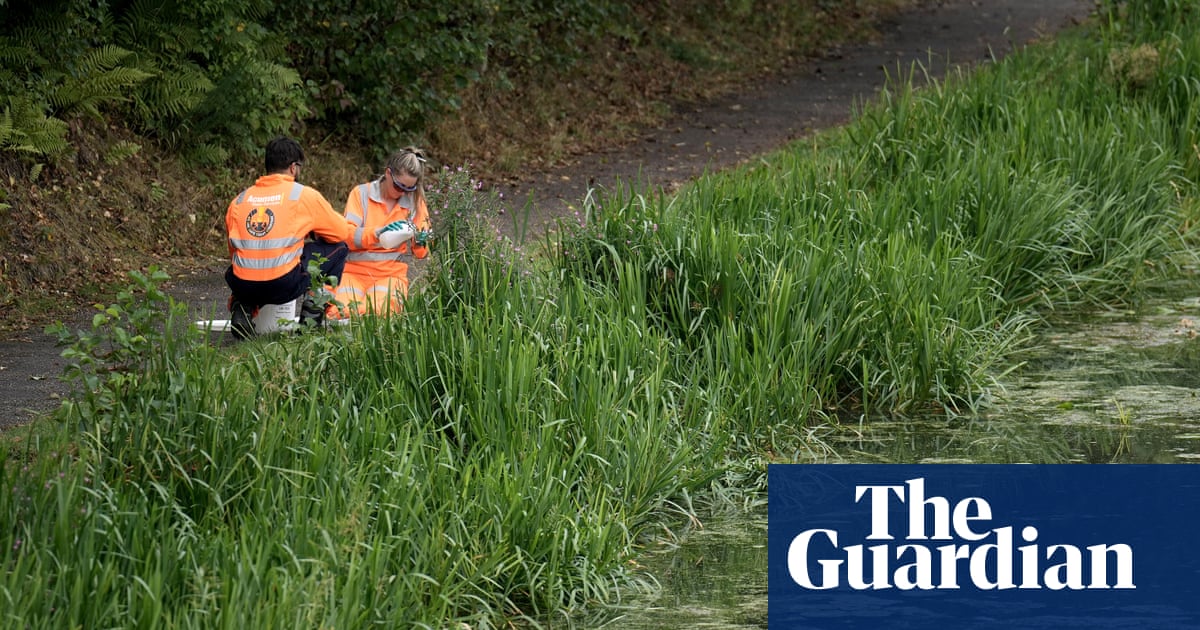When sodium cyanide leaked into a Walsall canal this month, leading to major incident being declared and miles of the waterway closed off, the Canal & River Trust was working in uncharted territory.
The charity is used to fighting pollution in the waterways that crisscross the country, but this type of chemical – and the extreme risk to public health that came with it – was not something it had tackled before.
“I’ve never known an incident like this in 20 years of pollution incidents on the canals,” said Karen Jackson, a contamination officer. “It’s not like when we’re dealing with oil or farm pollutions, where we know exactly what we need to do. With this, it’s unprecedented. We’re looking at lots of options but the fear is they may not be fully effective, and some are incredibly expensive.”
The operation to contain the poison and save the wildlife and ecosystem along this stretch of Black Country canal has been a mammoth effort by multiple agencies and volunteers.
Canals move more slowly than rivers, and the lock system can be used to quickly contain pollutants in one area. But the seriousness of this chemical spill meant that locks alone weren’t enough.
The trust worked quickly to build dams to place on either side of the immediate “red zone” where the cyanide had entered the water. These are now being guarded 24/7 so they cannot be damaged or removed by vandals.
With this rare type of pollutant, experts are unsure how to proceed. There are concerns that adding more chemicals to the water, already a “stressed environment”, to neutralise the cyanide could have unintended side-effects.
One option on the table is removing the contaminated water completely, and the charity is looking at using a tanker to remove some of the water this week in case rainfall causes the affected area to overflow.
“We’re dealing with 10m litres of water here, so that’s a massive volume of water to treat,” said Jackson. “We’re potentially looking at years for this problem to be sorted out.”
About 90kg of dead fish have already been removed from the canal and it is feared that the ecological impact could take months to fully materialise.
Henriette Breukelaar, the regional director of the West Midlands for the charity, said: “Some of those fish will have been eaten by birds, so what’s that going to do longer term to the birds? There’s still so many questions than answers. This area is part of an otter territory, and it was the site where we’ve last recorded water voles, so it’s a really environmentally rich area.”
The main concern is that the cyanide could seep into the sediment along the floor of the canal where it would be disturbed in the future by moving lock gates or dredging, and could repollute the area.
“We can’t be left with that legacy if this area is going to recover, because the disturbance of that silt is inevitable if the canal reopens for navigation,” Breukelaar added.
The charity has launched a fundraising drive to raise £10,000 for staff and volunteers to keep monitoring the wildlife in the area, and to do initial cleanup work. The campaign quickly surpassed its target and stands at nearly £20,000.
after newsletter promotion
Although the Environment Agency will get the polluter, a metal finishing company called Anochrine Ltd, to pay, the charity is concerned that waiting for costs to be covered before acting could risk the area becoming a “biologically dead zone”.
“The cleanup will of course be so much more than £10,000, but we need to start doing some of that biological testing to understand the impact more fully,” Breukelaar said.
There are more than 100 miles of canals in Birmingham and the Black Country, once crucial for transporting goods for the heavy industry that supported the area until the late 20th century.
Often concentrated in urban areas with restricted access to green spaces and back gardens, canals can be lifeline for the communities that live around them, as well as acting as a green corridor for wildlife.
Pleck, the Walsall estate where the cyanide leaked into the river, has neighbourhoods among the most deprived 10% in England, and has been covered in the local press for fly-tipping and antisocial behaviour.
“For us, a key milestone will be for it to be back to a state where the local community can go back to it to enjoy what is such an important space for them,” Breukelaar said.
“We know this is going to be a really big operation, and it could be months or years. But we’re going to rely on that goodwill, loyalty and love people have for the canal going forward, once the area is safe and we know what we’re dealing with, to help us bring the canal back to life.”
